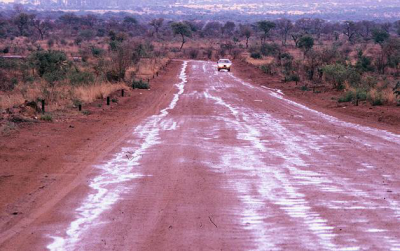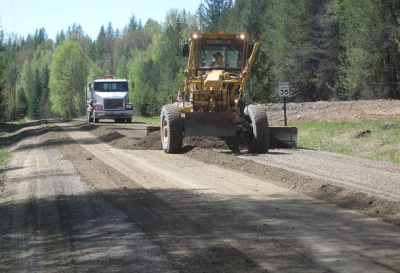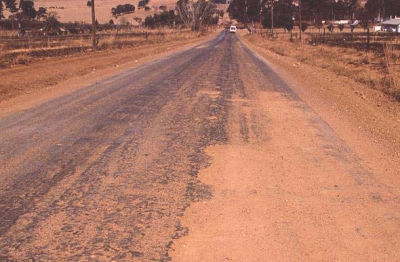Previous Chapter « Table of Contents » Next Chapter
Unpaved road maintenance is an evolving business. Roadway designs and aggregate specifications have improved. However, trucks are getting bigger and faster and the loads they haul are heavier, resulting in greater impacts to the road structure. Good quality aggregate is getting harder to obtain and more expensive as it must be hauled over longer distances. Motor graders are also bigger and more powerful, and have hydraulic steering controlled with joysticks, articulated blading, and air conditioned cabs with electronic gauges. Some people adjust to these changes better than others, but continuing education and training is necessary for everybody in order to optimize resources and productivity.
Blading a road with a chemical treatment
(Figure 12) often requires a different methodology from that to which most motor grader operators are accustomed. After gaining some experience with the mechanisms of dust control and soil stabilization, operators must adjust their practices to accommodate them or they may do more harm than good. This is easier said than done. Old habits die hard, and the fact that unpaved roads are no longer maintained the way they used to be, or as often, may be difficult for some to absorb.
Consequently, one of the biggest challenges when trying new techniques - including the materials used and road preparation methods discussed in this handbook - is to get everybody (managers, superintendents, supervisors, operators, crews, etc.) to buy in to the idea.

Figure 12. Photo. Crust on road treated with magnesium chloride.
One practitioner visited on the Scan noted that his best motor grader operator was the water truck driver because he would do what was asked of him to prepare the road for dust treatment and not let preconceptions developed through his own experience get in the way.
Resistance to change by operators accustomed to blading untreated roads in a specific way, the fear that the use of chemical treatments and consequent reduced maintenance requirements would result in layoffs, and the difficulty of maintaining an acceptable level of service in the face of high staff turnover were key learning points from the scan tour. Road managers said they often hear from operators whose perspective is, "I have bladed the road this way for 30 years. Why should I change?" Another Scan host shared that the life of his chemical treatment was reduced because contracted maintenance staff, who were not under his direction, continued to blade the road weekly despite his requests to reduce the frequency.
For a successful unpaved road improvement program, road managers should be in full control of the road maintenance staff and should communicate, through a formal training program, the purposes and benefits of new and improved unpaved road management practices. Address fears regarding layoffs, noting that chemical treatment makes better network-wide use of available resources and rarely entails any staff reduction. Include equipment operators in field reviews, demonstrations, early planning and formal training programs in advance of starting a chemical dust control program. Provide opportunities for your operators to visit with operators from other agencies who have programs in place. This can help address any concerns about trying new methods. Motivate operators by reminding them that their work helps to reduce public complaints, improve safety for all drivers, and reduce impacts to the environment. Successful chemical treatment programs also mean freeing up more funds to upgrade other roads in the network, which can further motivate employees by demonstrating forward progress in achieving unit, county or district goals. Achieving staff buy-in with clear expectations and some flexibility will go a long way to building a successful program.

Figure 13. Photo. Spray-on treatment to well-prepared road.

Figure 14. Photo. Mix-in treatment.
There are four points to accentuate when training staff.
Once operators learn that different treatments may result in different stabilizing mechanisms, they will be able to properly adjust their maintenance practices to the treatments applied. Additional training topics are listed in Appendix D.

Figure 15. Photo. Excess runoff of chemical treatment.

Figure 16. Photo. Maintenance of treated road.

Figure 17. Photo. Broken crust.